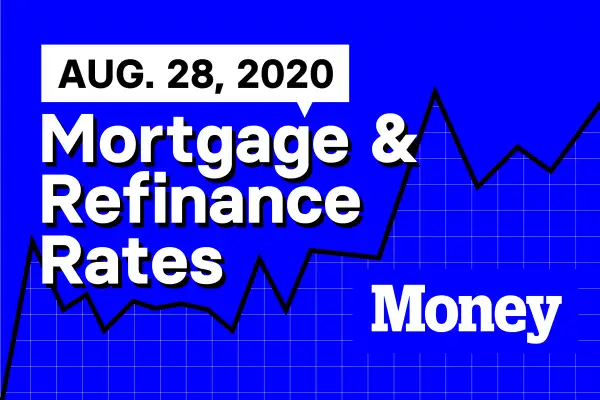Here Are Today's Best Mortgage & Refinance Rates for August 28, 2020

Borrowers with 700 credit scores were quoted an average rate of 3.508% to secure a 30-year fixed-rate purchase mortgage on Thursday, according to Money's survey of over 8,000 lenders across the country. At this credit score, roughly the national average, the average rate for a 30-year refinance was 4.458%. Our rates include discount points and are for borrowers putting 20% down.
| 30-year fixed-rate purchase mortgage |
| 3.508% |
| Rates of August 27, 2020 |
Borrowers in Illinois were quoted the lowest mortgage rates on Thursday—at a rate of 3.299%. Those in Nevada saw the highest average at 3.798%. The borrowers with the best credit scores, 740 and above, were quoted rates averaging 3.137%, while those with credit of 640 or below were given rates of 4.912%—a 1.775 percentage point spread.
You may be able to negotiate a lower rate if you shop around or if you have other accounts with the lender. Currently, some banks are hiking up advertised rates to keep demand in check, so you may be offered a lower rate if you reach out directly.
Freddie Mac’s widely quoted Primary Mortgage Market Survey put rates at 2.91% with 0.8 discount points paid for the week ending August 27. The mortgage purchaser’s weekly survey reflects borrowers who put 20% down on conforming loans and have excellent credit.
Refinance rates today
Our survey shows that the best rate for a 30-year refinance for someone with a 740 credit score was 3.664% on Thursday. Last August, the average mortgage rate (including fees) was 4.005%.
| 30-year fixed-rate mortgage refinance |
| 3.664% |
| Rates of August 27, 2020 |
A homeowner with a $200,000 mortgage balance currently paying 4.005% on a 30-year loan could potentially cut their monthly payment from $1,013 to $917 by financing at today’s lower rates. To determine if now is a good time for you to refinance, you will also want to consider the closing fees you paid on your current mortgage, how much your new lender is charging and how long you have left on your current mortgage. (Our picks for the best lenders for refinancing are here.)
What else is happening in the housing market right now?
The news of today, that could impact your home tomorrow.
The housing market continues to rebound as pending home sales increased during the month of July, according to data from the National Association of Realtors. It marks the third month in a row where homes under contract increased, with each of the real estate regions surveyed experiencing not only month-over-month but also year-over-year gains.
The NAR's Pending Home Sales Index, an indicator of home sales based on contract signings, reached a level of 122.1 in July. That's up 5.9% from June and 15.5% year-over-year. The index uses 100 as a baseline for the level of contract activity in 2001.
“We are witnessing a true V-shaped sales recovery as homebuyers continue their strong return to the housing market,” said Lawrence Yun, NAR’s chief economist. “Home sellers are seeing their homes go under contract in record time, with nine new contracts for every 10 new listings.”
Yun went on to forecast that existing home sales will increase to an annually adjusted pace of 5.8 million during the second half of 2020, which would bring the full year level to 5.4 million. This would be a 1.1% increase over 2019. Additionally, Yun forecast existing homes sales will reach 5.86 million during 2021, aided by a 4% expansion in the economy and interest rates that he expects to be around 3.2%. The main obstacle to the continued recovery in the housing market remains low inventory.
"Anecdotally, Realtors are telling me there is no shortage of clients or home seekers, but that scarce inventory remains a problem,” Yun said. “If 20% more homes were on the market, we would have 20% more sales, because demand is that high.”
Regionally, the Northeast experienced the highest growth, increasing 25.2% to 112.3, followed by the West, increasing 6.8% to 106.4, the Midwest with a 3.3% increase to 114.6 and the South, which ticked up 0.9% to 142.0. All regions experienced double-digit growth from year-ago levels.
The Week in Review
This week in housing and economic news.
While good news continue to predominate in the mortgage and housing sectors, worries about supply remain. While the labor market remained steady this week, the high number of unemployed has caused mortgage delinquencies to increase to their highest level in years.
A total of 8.22% of mortgage loans were in some stage of delinquency, according to the Mortgage Bankers Association. There were record increases of 2.15% in the 60-day delinquency rate and 3.72% in the 90-day delinquency rate, a signal of the depth of the unemployment crisis. On the slightly positive side, 30-day delinquencies decreased, possibly indicating that the number of homeowners in distress may be leveling out. The saving grace is that forbearance programs and loan modification plans put in place by lenders are keeping many homeowners from the risk of default for the time being.
Mortgage applications were down overall, with refinance applications down 10% week-over-week. Purchase loans were down a seasonally unadjusted 2% (although taking the adjusted number into consideration, they were up 0.4%), according to the MBA. Both types of loans were still well above 2019 levels, with increases of 34% and 33% respectively. Meanwhile, the number of loans in forbearance decreased one basis point to 7.2% of all mortgage loans, indicating that the pace of exits from the payment deferral programs is slowing down.
On slightly more positive news, both Fannie Mae and Freddie Mac announced the postponement of the Adverse Market Refinance Fee, originally set to be implemented on September 1, until December 1 after an avalanche of criticism from industry leaders concerned that the fee would make the cost of refinancing more expensive for homeowners.
Meanwhile, it remains a seller's market as Realtor'com's Housing Market Recovery Index showed that homes were selling 9 days faster than average than last year. Median listing prices were up 10.3% year-over-year, with no sign of slowing down at the moment. What continues to hold the housing market back is supply—housing inventory is down 37% from last year, according to the Index.
On the labor and economic front, unemployment held steady with a little over 1 million new initial claims made, meeting economists' expectations. It is the 22nd week where claims have been over one million since the pandemic began. Revised second quarter numbers for gross domestic product brought the annually adjusted decrease of 32.5% to a slightly better, but not by much, 31.7%.
Bottom line:
5 Ways Your Finances Instantly Change When You Buy a House
When Will It Get Easier to Buy a Home? 8 Experts on the Nation's Housing Shortage

